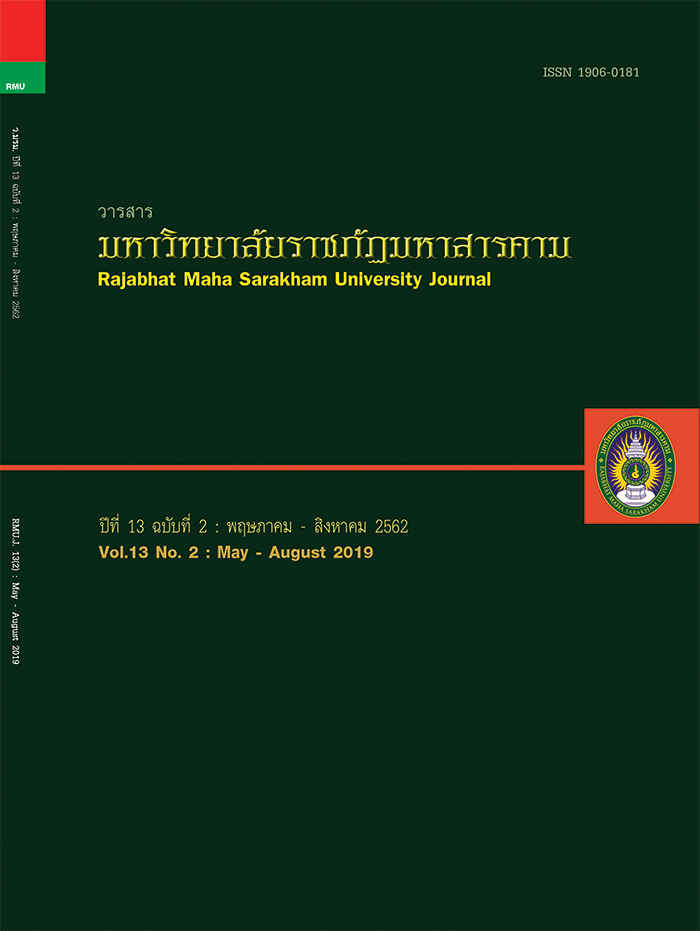การเปิดเผยทุนมนุษย์และผลการดำเนินงานของบริษัทจดทะเบียน ในตลาดหลักทรัพย์แห่งประเทศไทย
Main Article Content
บทคัดย่อ
การวิจัยครั้งนี้มีวัตถุประสงค์เพื่อศึกษาถึงสถานการณ์ปัจจุบันของการบัญชีทรัพยากรมนุษย์ในประเทศไทยด้านการเปิดเผยข้อมูลด้านทุนมนุษย์และเพื่อศึกษาความสัมพันธ์ของการเปิดเผยข้อมูลด้านทุนมนุษย์กับผลการดำเนินงานของบริษัทจดทะเบียนในตลาดหลักทรัพย์แห่งประเทศไทยกลุ่มตัวอย่างคือ บริษัทจดทะเบียนในตลาดหลักทรัพย์แห่งประเทศไทยในปี พ.ศ.2560 ซึ่งมีอยู่ทั้งสิ้น 250 บริษัทจาก 8 อุตสาหกรรมเครื่องมือที่ใช้ในการวิจัยคือ รายงานประจำปีและแบบแสดงรายการข้อมูลประจำปี (แบบ 56-1) โดยการเปิดเผยข้อมูลทุนมนุษย์ใช้วิธี Content analysis และผลการดำเนินงานได้ใช้ตัวชี้วัดทางการเงิน คือ ผลตอบแทนจากสินทรัพย์ (ROA)และ ผลตอบแทนจากผู้ถือหุ้น (ROE)โดยสถิติที่ใช้ในการวิเคราะห์คือ สถิติเชิงพรรณนา และ Multiple regression analysis ซึ่งผลการวิจัยพบว่าหัวข้อที่มีการเปิดเผยมากที่สุด คือ จำนวนพนักงาน และหัวข้อที่มีการเปิดเผยน้อยที่สุด คือ ค่าใช้จ่ายในการฝึกอบรมพนักงาน นอกจากนั้นยังพบว่าการเปิดเผยข้อมูลด้านทุนมนุษย์กับผลการดำเนินงานด้าน ROA ไม่มีความสัมพันธ์กัน แต่อย่างไรก็ตามกลับพบว่าการเปิดเผยข้อมูลด้านทุนมนุษย์มีความสัมพันธ์เชิงลบกับผลการดำเนินงานด้าน ROE
Article Details
1. บทความที่ลงตีพิมพ์ทุกเรื่องได้รับการตรวจทางวิชาการโดยผู้ประเมินอิสระ ผู้ทรงคุณวุฒิ (Peer Review) สาขาที่เกี่ยวข้อง อย่างน้อย 3 ท่าน ในรูปแบบ Double blind review
2. ข้อคิดเห็นใด ๆ ของบทความที่ลงตีพิมพ์ในวารสารมหาวิทยาลัยราชภัฏมหาสารคาม นี้เป็นของผู้เขียน คณะผู้จัดทำวารสารไม่จำเป็นต้องเห็นด้วย
3. กองบรรณาธิการวารสารมหาวิทยาลัยราชภัฏมหาสารคาม ไม่สงวนสิทธิ์การคัดลอกแต่ให้อ้างอิงแสดงที่มา
เอกสารอ้างอิง
[2] Abhayawansa, S., & Abeysekera, I. (2008). An explanation of human capital disclosure from the resource-based perspective. Journal of Human Resource Costing & Accounting, 12(1), 51-64.
[3] Roslender, R., Stevenson, J. E., & Kahn, H. (2012). Towards recognizing workforce health as a constituent of intellectual capital: Insights from a survey of UK accounting and finance directors. Accounting forum, 36(4), 266-278.
[4] Jelil, A. A., Eunice, O. A., Olusola, O.S. (2014). Optimizing the effectiveness of financial report through human resource accouting. International Journal of Accounting Research, 2(1), 30-42.
[5] Cherian, J., & Farouq, S. (2013). A review of human resource accounting and organizational performance. International Journal of Economics and Finance, 5(8), 74-83.
[6] Islam, M. A., Kamruzzaman, M., & Redwanuzzaman, M. (2013). Human resource accounting: Recognition and disclosure of accounting methods & techniques. Global Journal of Management and Business Research, 13(3), 1-9.
[7] Micah, L. C., Ofurum, C. O., & Ihendinihu, J. U. (2012). Firms financial performance and human resource accounting disclosure in Nigeria. International Journal of Business and Management, 7(14), 67.
[8]Sinjaru, Tanin. (2014). Research and Statistical Data Analysis by SPSS and AMOS. (15thed.). Bangkok: Business R & D. (in Thai).
[9]Al Mamun, S. A. (2009). Human resource accounting (HRA) disclosure of Bangladeshi companies and its association with corporate characteristics. BRAC University Journal, 1(1), 35-43.
[10]Onyam, E. G., Usang, I. E., & Enyisi, S. A. (2015). The impact of human resource accounting on the profitability of a firm empirical evidence from Access Bank of Nigeria Plc. Journal of Accounting and Research, 3(7), 76-94.
[11]Perera, A., & Thrikawala, S. (2012). Impact of Human Capital Investment on Firm Financial Performances: An Empirical Study of Companies in Sri Lanka. International Proceedings of Economics Development & Research, 54(3), 11-16.
[12]Chanprapaipat, A. (2010). Human Capital Disclosure in Thailand. An Independent Study for the Degree of Integrated Program of Business Administration and Master of Science in Accounting, Thammasat University. Bangkok. (in Thai).
[13]Srimongkolpitak, S., & Phadoongsitthi, M. (2012). Factors affecting voluntary employee information disclosure. Journal of Accounting Profession, 8 (21), 41-57.(in Thai).
[14]Taechoyotin, W., &Luewetwanit, T. (2017). Voluntary Disclosure of Human Capital of Thai Listed Companies. Journal of Accounting Profession, 14 (43), 48-62. (in Thai).
[15] Hair, J. F., Anderson, R. E., Babin, B. J., & Black, W. C. (2010). Multivariate data analysis: A global perspective (Vol. 7).Edinburgh gate.
[16] Khan, H. U. Z., & Khan, R. (2010). Human capital disclosure practices of top Bangladeshi companies. Journal of Human Resource Costing & Accounting, 14(4), 329-349.
[17] Kamardin, H., Bakar, R. A., & Ishak, R. (2015). Proprietary costs of intellectual capital reporting: Malaysian evidence. Asian Review of Accounting, 23(3), 275-292.


